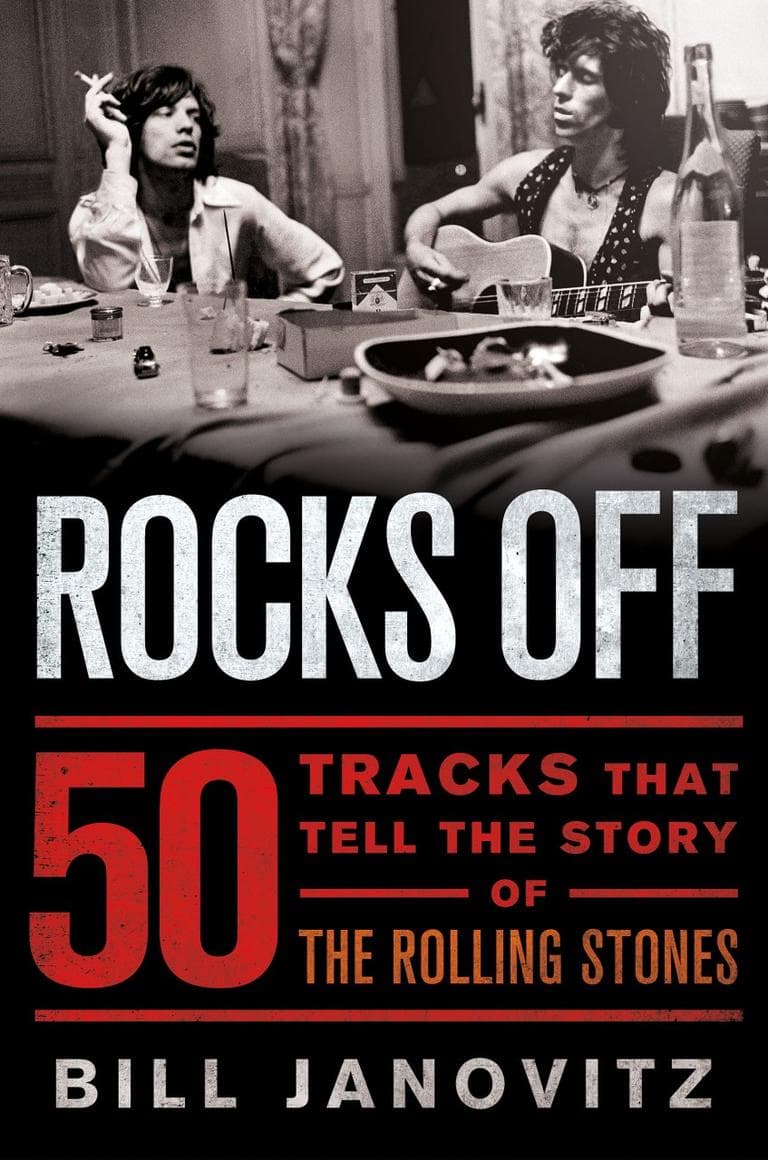Advertisement
50 Years On, The Stones Are Still Rocking

The Rolling Stones have been making their special blend of music since the early 60s.
Led by Mick Jagger and Keith Richards, they're still cranking it out, still playing to sold-out crowds in huge arenas.

A new book, "Rocks Off: 50 Tracks That Tell The Story Of The Rolling Stones," digs into their catalog of great songs (excerpt below).
Author Bill Janovitz, best known as singer and guitarist for the band Buffalo Tom, says the Stones weren't like other bands when they debuted in the early 1960s.
"The Beatles were still really writing about, sort of love songs," Janovitz said. "The Stones were writing, always, lust songs."
It was a marketing tool, but it was also indicative of the Rolling Stones' aesthetic and the changing culture.
"Here were these rebellious, kind of filthy guys," Janovitz said. "They were though of as, really, a parent's nightmare."
Over the decades, the Stones' style changed to incorporate new band members and shifting musical trends, including disco and funk.
"I think it's an amazing accomplishment to put aside all of the concerns, or to sort of get through it all, and collaborate with the same guys for 50 years," Janovitz said.
Advertisement
Book Excerpt: 'Rocks Off'

By Bill Janovitz
Tell Me
RECORDING:
January 1964, Regent Sound Studio, London
RELEASES:
UK LP: The Rolling Stones, May 1964
US LP:England’s Newest Hit Makers, May 1964
US single, June 1964, charting at number 24
“We’re making a record, can you believe this shit?”
—KEITH RICHARDS, reflecting on the band’s first sessions
First, that wobbly adolescence. Though the Rolling Stones had been around for two years by this point, this single, their sixth, marks the first time that the band released a Jagger/Richards–authored original song. The first Stones singles had been covers of Chuck Berry and Lennon/McCartney numbers. They would also cover Arthur Alexander and Buddy Holly hits. But to really take off as a band, they needed to eventually release one of their own. That’s where the money was—in song publishing. Famously, Oldham had taken the extraordinary step of “locking” Mick and Keith in a room with the directive to start writing original material. The duo came up with a handful of mostly forgettable compositions, including such chestnuts as “Shang a Doo Lang,” “My Only Girl” (later released by Gene Pitney as “That Girl Belongs to Yesterday”), and “Will You Be My Lover Tonight?” before penning “Tell Me.”
Like many of the Stones’ first songwriting endeavors, “Tell Me” did not mimic the band’s direct influences of hard Chicago blues and American rock ’n’ roll. Rather, they produced this sort of dark, acoustic-based folk/pop. Oldham attempted to influence the band more toward the fashionable pop styles of the day, while the band did their best to keep true to their self-image as an R&B band, with Brian in particular remaining a blues purist. With “Tell Me,” Oldham’s influence won out.
The “Tell Me” lyric is a string of clichés, but with enough urgency and snarl behind them to give indication of the Stones’ tougher stance than that of the Beatles. “But this time it’s different … You gotta tell me you’re coming back to me.” Though clearly a nascent example of the Jagger/Richards songwriting, many of the essential elements of the band, the traits that made them great in the long run, were already well established. They would go on to become expert rock ’n’ roll lyricists, despite the merely adequate start on their first original single. But it was the delivery and conviction that mattered more. And they got that right immediately. Even on their earliest recordings of cover songs, Mick sounded confident, to the point of cocksure swagger, like an old blues and soul singer who had seen it all. In 1963, this would have taken tremendous gumption from a skinny English college dropout. But his mates had his back, with surefooted, streetwise R&B that sounded leering and dirty somehow.
“Tell Me” nailed the sound Oldham was going for after the first single, Chuck Berry’s “Come On” (June 1963), fell “somewhere in that flawed middle ground between what the Stones wanted and what I wanted,” recalled Oldham in his memoirs. “Quite simply, it wasn’t Willie Dixon and it wasn’t the Ronettes.” (The Ronettes, not coincidentally, were burning up the charts in 1963 with their “Be My Baby.”) Keith says that their recording of “Come On” was “Beatle-ized.” They chose it because it was commercial and they wanted nothing more than the chance to make more records. “Then we refused to play it. Andrew Oldham almost went up the wall. ‘You’ve got a hit record and you don’t want to play it?!’ ‘We ain’t playin’ that goddamned thing … it’s awful.’”
The independently produced first single was no artistic triumph, but it served its purpose and got them signed to Decca. But by the Stones’ second single, a blistering loosey-goosey take on the Beatles also-ran, “I Wanna Be Your Man,” the strengths of the whole band were evident. It’s a shot of adrenaline, a youthful burst of energy, perhaps influenced by the song’s genesis itself. Again, the story sounds mythical. Oldham had almost literally bumped into Lennon and McCartney as they stepped out of a cab. He invited them to the studio where the Stones were rehearsing, and right then and there, the two finished off what had been a McCartney sketch of an idea, handing it to the Stones for their single. Mick and Keith observed and learned the art of songwriting at the feet of the masters, who made it look easy.
The Stones had been shoehorning in recording sessions during the daylight hours while playing live gigs almost every night. For those first few years, they had almost no days off. So by the time of the session for “Tell Me,” they had logged an impressive amount of hours together as a live band. Their self-assuredness is evident on the recording.
Keith starts the rhythm of “Tell Me” on the 12-string acoustic guitar. After the rather regal arpeggio flourish of the intro, his strumming begins unmoored from the backbeat (the two and four of the beat). It is a rhythm that seemingly does not resolve itself or reveal the obvious downbeat. If you are counting “one and two and three and four and…” the accents of his strumming are on the upstrokes (the “ands”). The next verse is even more on the upstroke. It creates a tension. The effect is like: come on man, you’re killing me, so that when the rhythm gets nailed down on the pre-chorus (“I know you find it hard…”), it comes as a welcome release and a resolution, which slams down harder on the chorus. Then Charlie drops out again and the verse teases you again.
This is one of the fundamental building blocks of the Stones’ sound as a band: Keith basically strumming away, trusting his bandmates to know where he is and to join him at the right time. As the years went on, Keith developed a highly rhythmic sense, driving, bobbing, and weaving, to the point of turning the beat around—that is, changing where beat one comes, making the band catch up to him. It is an outgrowth of his utmost confidence in the foundation laid down by Charlie, who himself has pointed out that the Stones are one of those rare bands where the drummer follows the rhythm guitar player rather than the inverse. The truth is that Charlie usually plays just slightly behind Keith, instinctually predicting where Keith is heading, and they mesh as one rhythm. This produces that almost undetectable drag that defines the sound of the Stones as much as anything else.
This mutual trust and intrinsic musical communication was clear right out of the gate with the Stones, and it is audible on “Tell Me.” Keith’s sense of rhythm guitar was informed in large part by listening to the records of the Everly Brothers. And in 1963, the Stones toured with the Everlys, along with Little Richard, a grueling run of dates that Oldham reckons gave the Stones a level of experience approaching that which the Beatles attained in Hamburg. The master showman, Little Richard, taught them a thing or two about dazzling an audience as well as the difference between club and theater performances, while the Everlys showed off pristine two-part harmonies and deft guitar playing. Don Everly’s driving acoustic guitar is a cornerstone of rock ’n’ roll, heard in the strumming hands of Pete Townshend and Paul Simon, as well as Keith’s.
“Tell Me” is quintessential early Stones. It has that somewhat baroque start but quickly gets into the Phil Spector-esque, street-tough-switch-blade of a chorus, a juvenile-delinquents-in-love vibe (so much so that it fits in perfectly on the soundtrack to Martin Scorcese’s 1973 film, Mean Streets). It stays loose, with Mick not even bothering to match up his own double-tracked lead vocal on the pre-choruses and chorus. Another signature of the Stones surfaces here as well: Keith’s loose harmony (sung live into the guitar mic as he strummed) paired with Mick’s assertive vocals. Keith chugs in on an overdubbed electric guitar and slides his fingering up the neck during the first pre-chorus. There is an inarticulate chord-arpeggio for a solo, also from Keith. Oldham’s early love of the tambourine results in the instrument front and center in the mix, struck with a drumstick. The tempo quickens markedly out of the solo, but it somehow manages to hold together.
Taking influence from those older Chess Records releases, as well as contemporary records coming out of Memphis on labels like Stax/Volt, “Tell Me” sounds crude, presented with very little polish. Like those blues and soul records, it was about the overall feeling. In classic soul music, no one was worrying if the bass player was slightly off on a particular bar. Yet the looseness of soul was a deceiving sort, generally played over a particularly tight rhythm section, with the rest of the band playing in a laid-back pocket slightly behind or around the beat. The rhythm of the music literally swings within the beat. Otis Redding’s 1962 recording of “Pain In My Heart” (which the Stones went on to record) is a good example. There is a great deal of swing to the drums and bass, but drummer Al Jackson Jr. holds down the ensemble with a steady pattern on the hi-hat, allowing the horns, organ, and most important, Redding himself, to roam.
Jackson was a direct influence on Charlie Watts and Ringo Starr, who reclaimed this swinging style of drumming back from early-1960s English producers, whose “correct” and “polite” technique dictated that bass drum and bass guitar should always be locked in together (to the point that Ringo was actually jettisoned on a couple of early Beatles tracks in favor of a session drummer). Keith explains the greatness of Charlie and his essence to the foundation of the Stones sound:
… I love to watch his foot … Even if I can’t hear him, I can play to him just by watching. The other thing is Charlie’s trick that he got, I think from Jim Keltner or Al Jackson. On the hi-hat, most guys would play on all four beats, but on the two and the four, which is the backbeat, which is a very important thing in rock and roll, Charlie doesn’t play, he lifts up. He goes on to play and pulls back. It gives the snare drum all of the sound, instead of having some interference behind it.
Oldham, his production experience quite limited, helped buffer the Stones themselves from those “polite” English engineers who might otherwise have sucked the life out of the music in the control room. Oldham barely knew anything about making music, never mind how to engineer. His role as producer was more in line with his role model, Phil Spector, a big-picture point of view. But while Spector composed music as well as produced it, Oldham approached the position more as an in-house A&R (artists & repertoire) man, as well as liaison between the band and the engineers, than as a set of ears. Oldham, though, found a willing accomplice in Bill Farley, who was the house engineer at Regent Sound Studios. Farley is described as an ambitious, eager-to-please guy who had the ability to translate what Oldham would describe to him abstractly, getting it down on tape the way they wished to hear it. “We didn’t have a George Martin,” says Keith. “We had the band. And we had Oldham.” Ian Stewart said, “People like Mick and Keith didn’t need a George Martin.”
“When they first arrived,” Farley later recalled, “no one had thought about arrangements. They just busked it until they got the feeling of the number. There was no dubbing. They just told me exactly what they wanted as soon as the number had been worked out. How it turned out so well in the end I never really knew.”
Oldham describes Regent itself as “no larger than an average good-sized hotel room,” with the control room the size of the hotel room’s bathroom, “but for us it was magic.” The sound from the instruments leaked into the microphones of the others, the drums coming through the microphone on Keith’s acoustic. It gave the band their own version of Phil Spector’s Wall of Sound. The Stones would go on to record all of their first album there.
Within weeks of the album’s release, they went from playing clubs to being pop stars. The debut record, recorded in about ten days, sold 100,000 copies in its first week, going straight to number one and staying in the position for three months. By now, they were rarely being referred to as an R&B band. As with the increasingly successful Beatles, the Stones were no longer simply an R&B nightclub draw. They were now a “beat group,” the marketing term of the day in England for post-Beatles pop acts.
When the LP in the States dropped, the cover had a screaming headline across the top: ENGLAND’S NEWEST HIT MAKERS: THE ROLLING STONES. It would be a lot to live up to.
Excerpted from the book ROCKS OFF by Bill Janovitz. Copyright © 2013 by Bill Janovitz. Reprinted with permission of St. Martin's Press, LLC.
Guest
- Bill Janovitz, author of "Rocks Off: 50 Tracks That Tell The Story Of The Rolling Stones." He's also singer, guitarist and songwriter for the alternative rock band Buffalo Tom.
This segment aired on July 23, 2013.